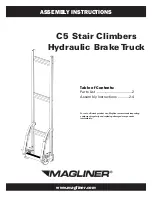
BRAKES 5-94
F ig . 136-Removing " F a il-S a fe " Assembly
C leaning and Inspection (Figs. 133 and 134)
1. It is recommended that all brake chambers be re
moved,
disassembled, inspected and thoroughly
cleaned at the time that brakes are relined or at one
year periods, whichever occurs first (also dependent
upon type of operation and operators experience).
2. Clean all metal parts thoroughly, using a suitable
cleaning fluid. Blow dry with air or wipe dry with
cloth.
3. Inspect piston cap for signs of damage or excessive
wear. Piston should slide freely inside cap assembly.
Replace piston if badly worn or damaged.
4. Inspect inside walls of cap assembly for scratches,
scores, or excessive wear. Slightly worn spots may
be removed with crocus cloth. Inspect external
threads on cap for rust or corrosion.
5. Inspect piston seal for cracking or deterioration.
Inspect expander and expander retaining plate for
deterioration. Replace piston assembly if necessary.
6. Inspect pressure housing for scratches, scores, or
excessive wear. Examine all parts for obstructions
and remove any foreign matter.
7. Examine spring in cap for deterioration or rust. In
spect release bolt for signs of rust on threaded por
tion. Unless spring or bolt is in very bad condition,
replacement should not be necessary. See "Caution"
in step 10 of "Removal and Disassembly," previously.
8. Discard O-ring and rubber washer. Replace with
new parts.
9. Examine diaphragm plate rod boot (in non-pressure
housing) for deterioration or cracks. If deterioration
or other damage is evident, replace as follows:
a. Pull diaphragm plate rod, wedge rod guide and
boot out of wedge rod and mounting tube respec
tively.
b. Remove guide and boot from diaphragm plate rod
and install new boot on plate rod. Replace wedge
rod guide „
c. Apply a liberal amount of rubber cement to boot
flange and mating surface on non-pressure hous
ing.
d. Position plate rod on wedge rod and hold rubber
boot flange tightly against housing surface. Flange
should seal tight to keep any moisture or foreign
matter from falling into actuation components.
NOTE:
Be careful not to disturb wedge and
roller mechanism inside actuation housing when
repositioning plate rod on wedge rod.
Assem bly and Installation
Refer to Figure 133 (also Refer to Figure 134 for
components).
1. Install O-ring in groove in pressure housing.
F ig . 137-Removing Pressure Housing with "Strap" Wrench
CHEVROLET TRUCK SERVICE MANUAL
Summary of Contents for 10 Series 1968
Page 1: ...ST 1 3 3 SB...
Page 3: ...w w...
Page 52: ...HEATER AND AIR CONDITIONING 1A 21 Fig 32 Charging Schematic CHEVROLET TRUCK SERVICE MANUAL...
Page 67: ......
Page 128: ...BODY IB 61 Fig 135 A uxiliary Seat CHEVROLET TRUCK SERVICE MANUAL...
Page 132: ...Fig 4 1 0 3 0 Series Truck Frame...
Page 133: ...Fig 5 4 0 6 0 Single A xle Truck Frame E x c Tilt Cab...
Page 135: ...Fig 7 4 0 6 0 Series Tilt Cab Truck Frames...
Page 139: ...w...
Page 169: ...fit w...
Page 233: ...I...
Page 248: ...BRAKES 5 15 TD 50 60 Fig 26 Parking Brake Cables T Models CHEVROLET TRUCK SERVICE MANUAL...
Page 347: ......
Page 389: ......
Page 393: ......
Page 411: ...ENGINE FUEL 6M 18 Fig 18A V 8 Typical CHEVROLET TRUCK SERVICE MANUAL...
Page 525: ......
Page 551: ......
Page 583: ...CHASSIS SHEET METAL 11 12 Fig 20 Designation and Name Plate CHEVROLET TRUCK SERVICE MANUAL...
Page 587: ...ELECTRICAL BODY AND CHASSIS 12 2 Fig 1 Fuse Panel CHEVROLET TRUCK SERVICE MANUAL...
Page 611: ...r ELECTRICAL BODY AND CHASSIS 12 26 9 CHEVROLET TRUCK SERVICE MANUAL...
Page 663: ......
Page 686: ...w...
Page 698: ...SPECIFICATIONS 12 ENGINE TORQUES CHEVROLET TRUCK SERVICE MANUAL...
Page 713: ...9...






































